
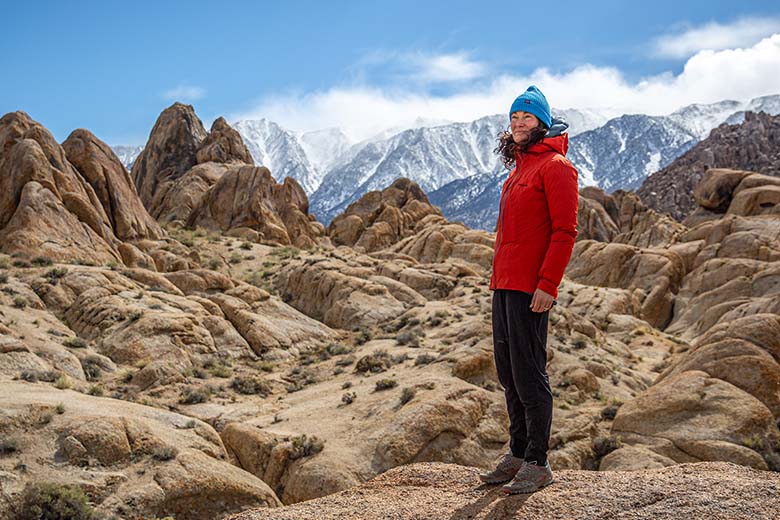
Price: $379
Weight: 9.5 oz. (women’s small)
Waterproofing: 3L H2No Performance Standard
What we like: Trustworthy protection and alpine-ready features in a competitively light package.
What we don’t: Overly compromised for wearing casually; pricey for what you get.
See the Women's M10 Storm Jacket See the Men's M10 Storm Jacket
Patagonia recently expanded their rain shell collection, adding two new lightweight options to their lineup: the running-focused Storm Racer and alpine-ready M10 Storm. A replacement for the Storm10, the M10 Storm shares that design’s technical intentions but is impressively well balanced for such a light and purpose-built design. I put the women’s version to the test in all sorts of conditions and environments, from heavy rain on Vancouver Island to spring snow in the eastern Sierra. While Patagonia did make some notable compromises to keep weight low—including no pit zips or hand pockets—the M10 Storm lives up to its billing as a capable companion for fast-and-light mountain objectives. Below I break down my experiences with the M10 Storm. To see how it stacks up in the market, check out our articles on the best hardshell jackets, best rain jackets, and best women’s rain jackets.
Patagonia’s M10 Storm Jacket toes the line between our hardshell and rain jacket categories, combining a 3-layer H2No Performance Standard membrane (Patagonia's proprietary waterproofing), an alpine-ready feature set, and a supple 30-denier (D) face fabric. In testing, protection has been predictably solid, effectively shrugging off everything from heavy rain to shoulder-season snow. During one outing on Vancouver Island, we experienced hours of relentless rain while backpacking, and the M10 Storm showed no signs of weakness. It fared equally well in the variable eastern Sierra in early spring, as well as during a very windy trip into the Moab backcountry. Given my positive experiences thus far, I have no hesitations about bringing the M10 Storm along when inclement weather is in the forecast.

Patagonia also equipped the shell with several weather-ready features for battening down the hatches. In addition to the adjustable and helmet-compatible hood (more in “Key Features” below), you get hook-and loop cuffs that are easy to cinch tight and feature a grippy lining that helps them stay in place when reaching overhead. There’s also an internal storm flap backing the waterproof main zipper, along with a zipper “garage” at the top for added comfort and assurance against moisture. The chest pockets are also highly water-resistant and trustworthy enough that I frequently stash valuables like my phone inside (and have had no issues to date). Finally, the hem features a single toggle on the right side for cinching the waist.
The M10 Storm Jacket is a decidedly minimalist piece, so it’s not too surprising that there are no pit zips for dumping excess heat. That said, I still managed to stay reasonably comfortable throughout testing. For reference, I wore the jacket while hiking and running on trails near Whitney Portal in cold and windy weather without sweating through the shell, and I was also fine while backpacking in humid rainforests on Vancouver Island. All told, I’d categorize the M10 Storm’s breathability as about average, but those who run warm may want to consider a jacket with pit zips for regulating temperature while on the move.

While not a standout in comfort, the M10 Storm Jacket is no slouch. Most notably, the thin knit backer is cozy against bare skin and gives the interior a relatively supple and pliable feel. It also allows the jacket to slide easily over baselayers and midlayers. My only complaint is that the inside can grow slightly clammy during exertion, which isn’t uncommon but meant that I frequently paired the jacket with a thin long-sleeve shirt to avoid stickiness against my skin.
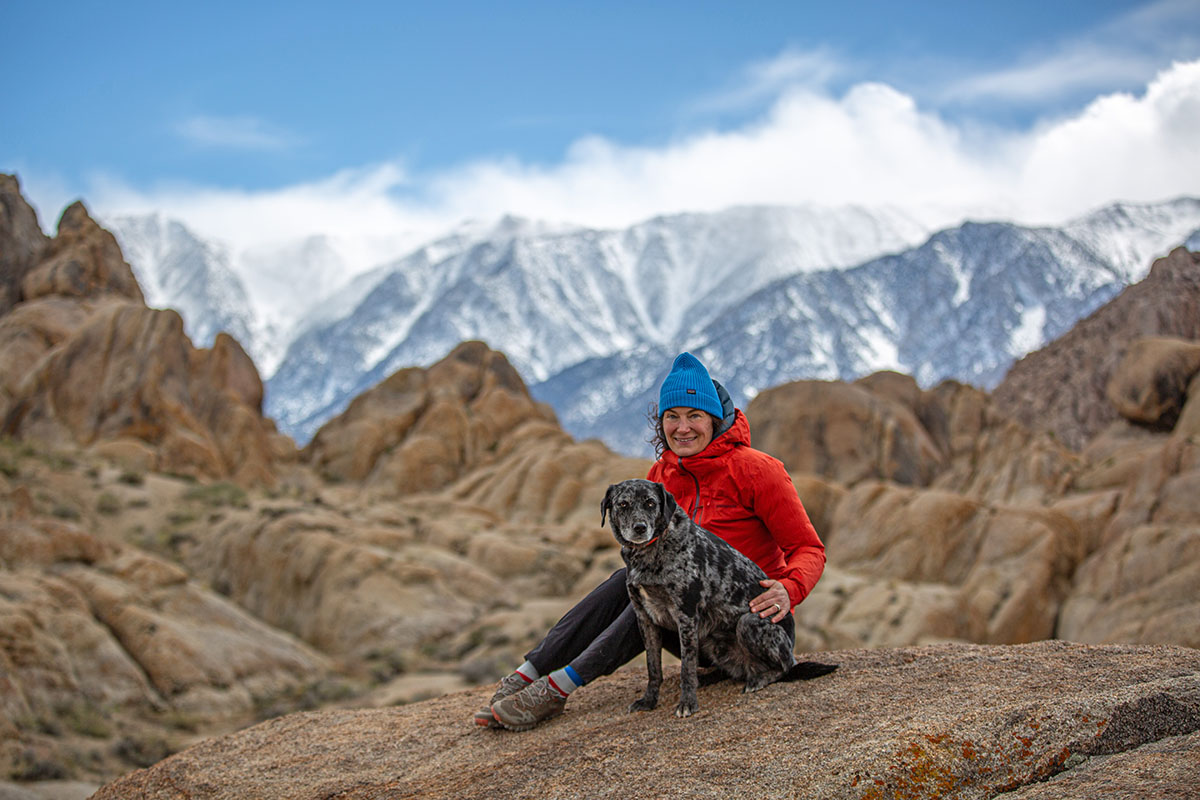
At 9.5 ounces on my scale for my women’s size small (listed weight is a little higher at 9.9 oz.), the M10 Storm Jacket is an impressively feathery piece—great for weight-conscious missions into the alpine. For comparison, Arc’teryx’s Norvan Shell Jacket that I recently tested undercuts the M10 Storm at a scant 6.7 ounces, but its feature set is notably more limited. A closer comparison is Black Diamond’s Fineline Stretch Shell, which clocks in at 9.5 ounces but boasts a downgraded 2.5-layer construction. In other words, the M10 makes fewer sacrifices than most in its weight class.
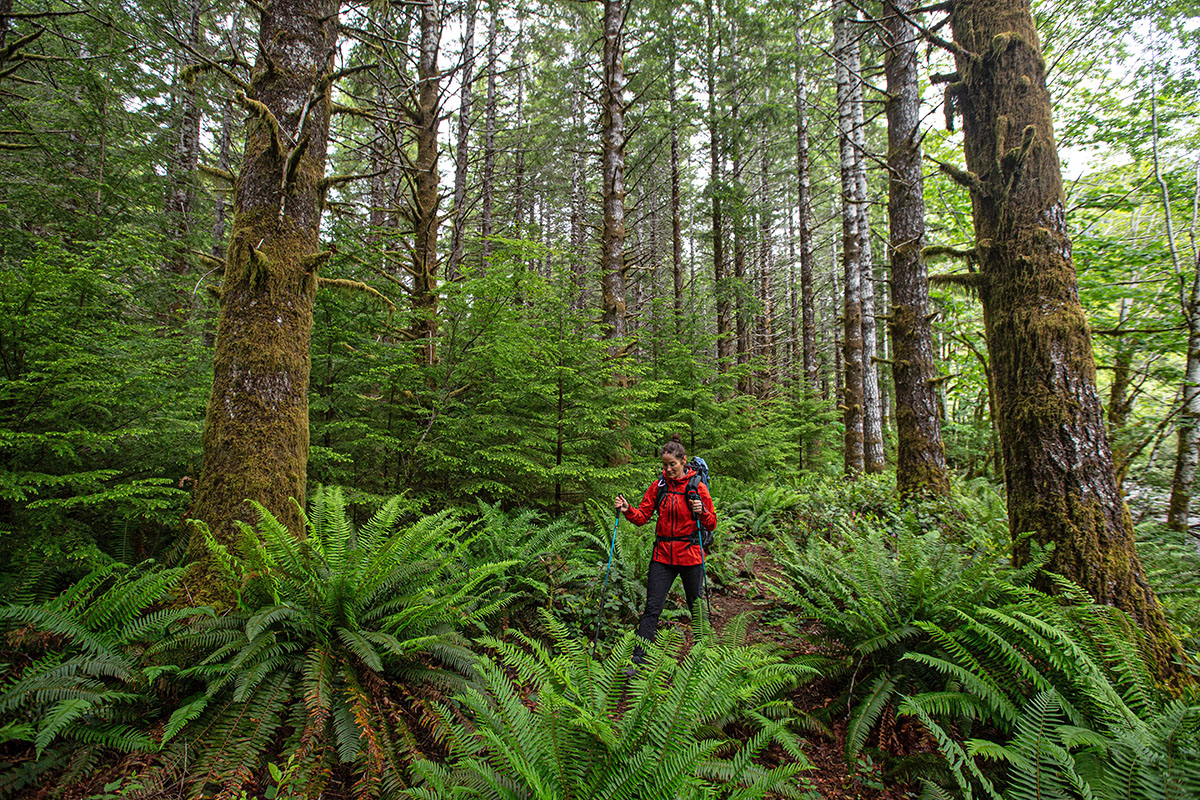
In line with its low weight, the M10 Storm Jacket packs down competitively small. I love that it easily stuffs into its chest pocket—there’s little effort required and no tension on the double-sided zipper, which bodes well for long-term durability. Once packed down, the package is about the size of a 25-ounce water bottle and can be compressed down a little further when space is at a premium. Given its small size and lack of heft, I have no qualms about stashing the M10 Storm in my pack on multi-day backpacking and bikepacking trips.
Patagonia is a longstanding leader in the rain shell market, and the M10 Storm Jacket nicely reflects their expertise. Despite its minimalist intentions, the jacket’s 30D shell fabric is thicker than expected (many ultralight competitors—including the past-generation Storm10—drop down to 20D) and has held up flawlessly throughout testing. Importantly, Patagonia opted for ripstop nylon, which is more abrasion-resistant than standard nylon and has handily fended off snags and tears while trudging along overgrown trails. All of the smaller components are holding up equally well, from the hook-and-loop cuff adjustments to the zippers and taped seams. All in all, I’ve been very impressed by the jacket’s durability thus far and expect it to last many more seasons without issue.

Designed for the alpine, the M10 Storm has a very practical hood design for technical objectives like climbing. First and foremost, the hood comfortably accommodates a climbing helmet with no restriction to movement. It’s also easy to fine-tune with a single drawcord at the back, which tweaks the brim, as well as two adjustment points at the base of the collar that tighten the aperture when pulled. In terms of coverage, the collar reaches up over my chin and makes it easy to tuck my face inside when hiding from the elements. Patagonia even included a Recco reflector in the hood, which is a passive device that will help rescuers find you in the event of a backcountry emergency.

Storage is one area where the M10 Storm makes some significant compromises in the name of weight savings. Most notably, there are no hand pockets. Instead, Patagonia opted for two large chest pockets that are easy to access when wearing a backpack or climbing harness. Though they’re the same size, the left chest pocket has a noticeably longer zipper than the right, which is great for storing larger items like maps (it also serves as the jacket’s stuff sack) but results in a slightly odd an asymmetrical appearance. It doesn’t help that the tops of the zippers are covered by angled fabric flaps, which provide added assurance for protecting valuables but contribute to the slightly awkward look. And it goes without saying that hand pockets would be the better choice for more casual uses like hiking and wearing around town. But overall, I think Patagonia did a decent job balancing weight and functionality with the storage layout.

The M10 Storm Jacket is dubbed a “slim” fit by Patagonia, which translates to an athletic cut that moves with your body. For reference, my usual women’s small fit true to size with enough room to accommodate a lightweight down jacket underneath (I often layered it over my Rab Mythic G or Arc’teryx Cerium Hoody). Additionally, the arms were the perfect length, even when reaching overhead, and I had zero issues with restriction thanks to the slight amount of stretch in the fabric. All in all, I feel that Patagonia nailed the fit part of the equation: The M10 is streamlined enough to stay out of the way on technical objectives but not so tight that it’s uncomfortable to wear while performing camp chores or relaxing after a long day out.

Many outdoor brands are putting a strong focus on sustainability of late, and Patagonia is at the helm. In this case, the M10 Storm Jacket features a 100%-recycled shell fabric that uses a PFAS-free DWR coating. For reference, PFAS stands for per- and polyfluoroalkyl substances, which are known as “forever chemicals” and proven to have negative effects on both human health and the environment. The jacket is also produced in a Fair Trade Certified factory, which indicates Patagonia put extra money into production to ensure workers are compensated fairly, have access to safe working conditions, and can fund community projects like healthcare and childcare programs. Taken together, these measures only add to the M10 Storm’s all-around appeal.

The review above covers the women’s M10 Storm Jacket, and there are a few other options in the collection. For starters, the men’s M10 Storm Jacket costs the same and shares an identical overall construction and feature set but weighs a little more at 10.9 ounces and comes in different colorways. Patagonia also offers the men’s M10 Storm Anorak for $399, which trades the jacket’s full-length main zipper for a 3/4-length design, swaps in a thinner 20D shell fabric, and checks in at 10.6 ounces. To complete your kit, there are M10 Storm Bibs for women and M10 Storm Pants for men, both of which use the same 3-layer H2No construction as the jackets.

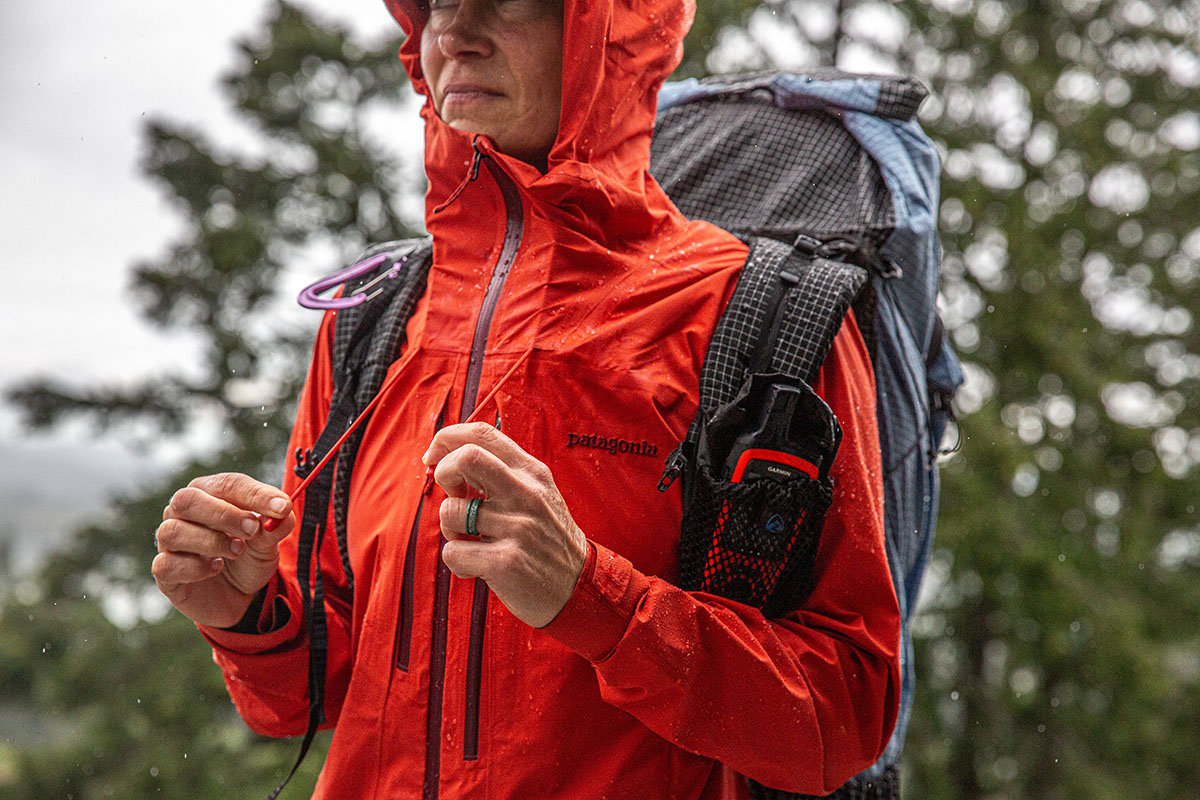
| Jacket | Price | Weight | Waterproofing | Denier | Pit Zips | Pockets |
|---|---|---|---|---|---|---|
| Patagonia M10 Storm Jacket | $379 | 9.9 oz. | 3L H2No | 30D | No | 2 |
| Patagonia Granite Crest | $279 | 12.6 oz. | 3L H2No | 30D | Yes | 3 |
| Patagonia Super Free Alpine | $599 | 13.4 oz. | 3L Gore-Tex ePE | 40D | Yes | 3 |
| Black Diamond Fineline Stretch | $180 | 9.5 oz. | 2.5L BD.dry | Unavailable | Yes | 3 |
| Arc'teryx Beta SL Jacket | $500 | 10.6 oz. | 3L Gore-Tex ePE | 40D x 70D | Yes | 3 |
As we touched on above, the M10 Storm toes the line between a rain jacket and hardshell. Those who don’t need the alpine-ready protection and features can save considerably with Patagonia’s Granite Crest, which falls under the former category. Like the M10 Storm, the Granite Crest features Patagonia’s 3-layer H2No membrane for trustworthy protection but is much more versatile for a range of outdoor uses thanks to the addition of hand pockets, pit zips, and a roomier “regular” fit that makes it easier to layer underneath. However, the Granite Crest is heavier than the M10 Storm at 12.6 ounces and notably bulkier as a result, making it less ideal for weight- and space-conscious alpine missions. In the end, a final decision will come down to your objectives and priorities, with the Granite Crest being the more well-rounded but less specialized option.

At the other end of the spectrum is Patagonia’s Super Free Alpine Jacket, which is a premium hardshell that’s purpose-built for technical mountain objectives. While undeniably pricey at $599, the Super Free Alpine comes with a host of advantages, including an upgraded 3-layer Gore-Tex ePE Performance membrane for unrivaled protection, a lightly insulated hood for fending off frigid alpine winds, two-way pit zips, and a drop-tail hem with cut-outs at the hip for maximizing coverage without sacrificing mobility when high-stepping. We also prefer the Super Alpine Free’s storage layout, which comprises two harness-friendly hand pockets and an interior chest pocket for stashing valuables. Price will be the biggest deterrent for most, and weight does increase because of the added features (13.4 oz.), but the Super Alpine Free represents the crème de la crème for truly demanding mountain missions.
Moving away from Patagonia’s collection, another competitively light option to consider is Black Diamond’s Fineline Stretch Shell, which was previously called the Stormline Stretch. For a very palatable $180, the Fineline manages to stack up very closely to the M10 Storm in weight at just 9.5 ounces while tacking on functional additions like hand pockets and pit zips for ventilation. The rest of the feature set lines up similarly well, including water-resistant zippers, an adjustable and climbing helmet-friendly hood, and a cinchable hem and cuffs. The only notable drawback is the downgraded 2.5-layer construction, which is less impervious than the Patagonia’s 3-layer design. But dollar for dollar, we consider the Fineline Stretch to be the clear leader in value and far more versatile for wearing casually.
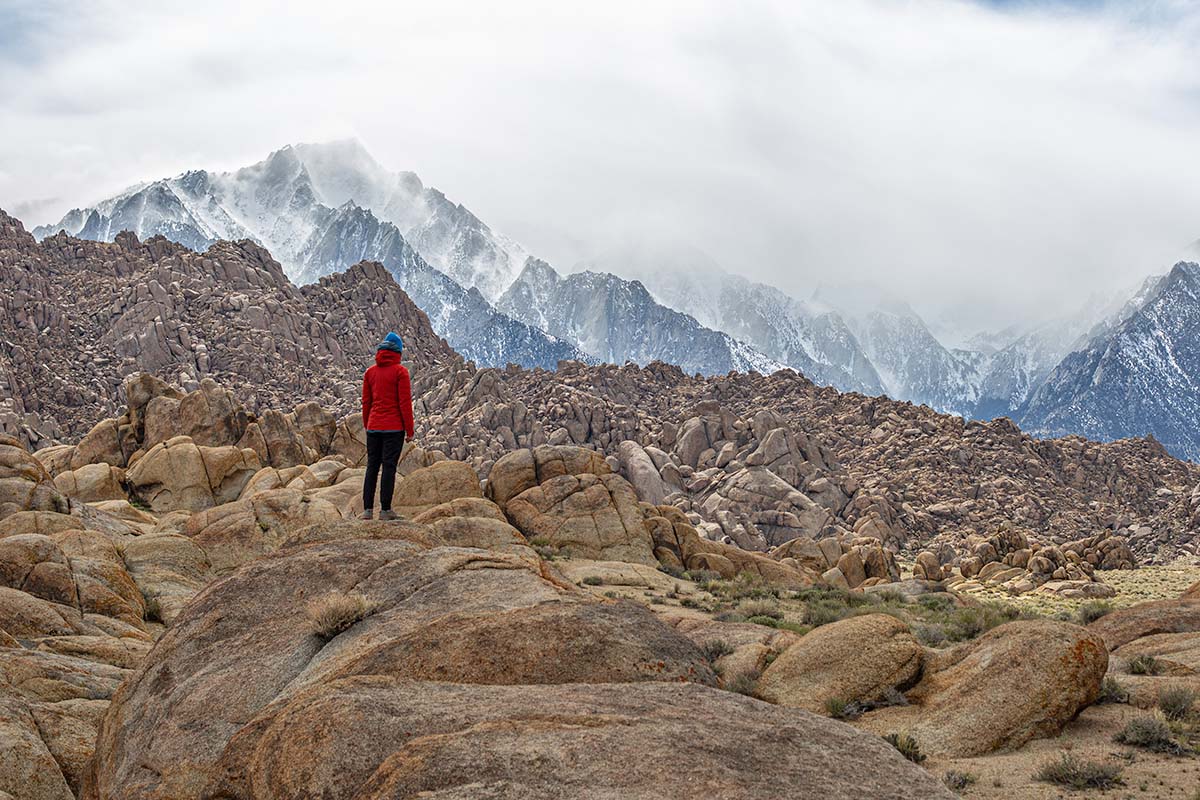
Finally, we’d be remiss not to include an alternative from technical specialist Arc’teryx. While more of an all-rounder than the M10 Storm, their Beta SL Jacket strikes a nice middle ground for many outdoor-goers. In this case, Arc’teryx opted for a proven 3-layer Gore-Tex membrane with their cozy C-Knit backer for added next-to-skin comfort. You also get the brand’s well-loved StormHood, which is both helmet-compatible and easy to adjust, along with pit zips for quickly regulating temperature, a thicker (40D x 70D) face fabric, and a more practical storage layout that includes two hand pockets and an internal chest pocket—all for just 0.7 ounces more than the M10 Storm. The clincher for many will be price, with the Beta SL coming in at a steep $500, but it’s hard to argue with Arc’teryx’s attention to detail and overall build quality.
Editor’s note: We usually provide a live price comparison table below our outdoor gear reviews, but the M10 Storm is currently only available directly through Patagonia. You can see the M10 Storm Jacket page here and support us in the process. Thanks!